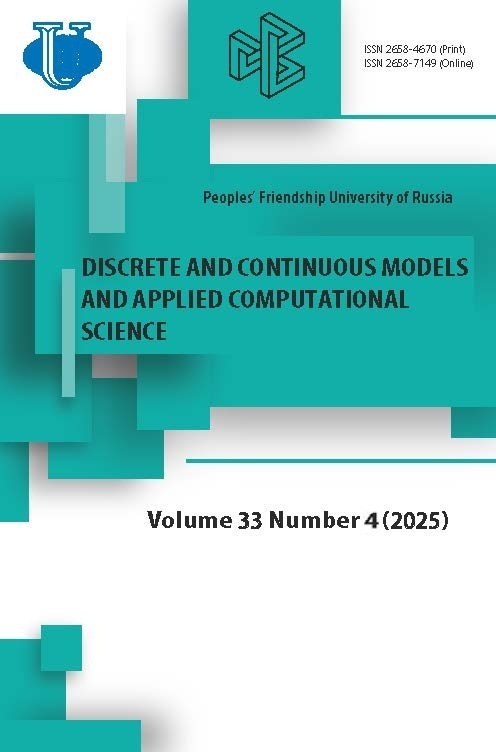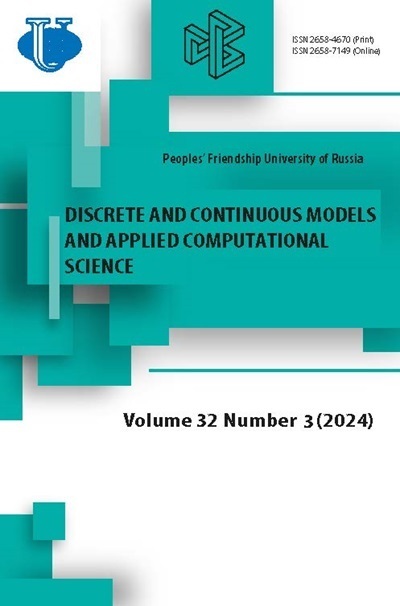Maintaining the reliability of communication networks while continuing operation of optical cables beyond their warranty period
- Authors: Paltsin D.A.1, Tsym A.Y.1
-
Affiliations:
- M.I. Krivosheev National Research Centre for Telecommunication
- Issue: Vol 32, No 3 (2024)
- Pages: 294-305
- Section: Computer Science
- URL: https://journals.rudn.ru/miph/article/view/43410
- DOI: https://doi.org/10.22363/2658-4670-2024-32-3-294-305
- EDN: https://elibrary.ru/BGKJTK
- ID: 43410
Cite item
Full Text
Abstract
Currently, an increasing number of fiber-optic communication lines are reaching the end of their predetermined service life, yet the quality indicators of these lines still allow for continued operation. To extend the actual operational life of these lines, it is necessary to conduct high-quality monitoring of both the current status of all components and the dynamics of key indicators. This article proposes a method for addressing the challenge of maintaining communication network reliability while continuing to use optical cables after their warranty period has expired. A study of random values of the attenuation coefficient and polarization mode dispersion of an optical fiber, supported by actual operational data from a network segment, shows high temporal stability in the attenuation coefficient and polarization mode dispersion of optical fiber type G.652. This conclusion allows us to discuss the continued operation of optical cables after the warranty period. To analyze the key aging metric, mathematical models are used that take into account the physical and chemical properties of cables as well as the conditions of their proof-tests. Using an example related to the current state of Russian fiber optic networks, we calculate the number of emergency reserve elements necessary to maintain the reliability of their operation. Practical recommendations for the placement of emergency reserve are also provided.
Full Text
1. Introduction By definition, the service life of a cable is the period of time from the start of its operation until it reaches its limit state, where further operation becomes unacceptable, impractical or impossible, or restoration of its operational state is not feasible. This limit state is determined in advance in regulatory, technical, or project documentation. Thus, on the one hand, it may seem contradictory to talk about the reliability of a communication transport network when its basis-the optical cable [1]-has reached its limit state. However, it is difficult to determine the exact limit state of an optical cable. In practice, the term “service life” refers to the duration of time determined by the manufacturer, during which the failure rate caused by aging (fatigue) is not expected to increase exponentially. This usually occurs between 25 and 30 years. So, the service life can be seen as an extrapolated indicator of reliability, which can be estimated (in point or on interval) by extrapolating calculations, tests, and/or operational data to a different duration of operation and different operating conditions. It is important to consider two factors. Firstly, the expected service life of optical cable in general and optical fibers in particular is determined with a high degree of uncertainty, and therefore, cable manufacturers specify this in the passport-certificate for the construction length with a considerable margin. Secondly, operating companies have technical and organizational resources to influence the operational reliability indicator, which can be assessed by point or interval analysis based on operational data. In particular, the conditions of laying and operation with a limitation of the permissible bending radii of optical fibers can significantly reduce the mechanical loads on them and increase their service life [2]. Based on the above, it is clear that the problem formulation is correct and relevant. To find an informed solution, we will separately consider the issues of the temporal stability of optical fiber parameters. 2. Study of the temporal stability of the optical fiber attenuation coefficient The main distinguishing feature of optical fiber as a signal transmission medium is the random nature of the attenuation coefficient. This coefficient depends on a number of design parameters, including the longitudinal uniformity of the core, the eccentricity and non-roundness of the core, and the longitudinal uniformity of the material. Other factors that can affect the attenuation include extraneous inclusions in the quartz, microcracks, and microbends. The culture of producing optical fiber and optical cable significantly impacts the attenuation coefficient value. Studies [3-5] indicate that the range of the attenuation coefficient spans from the minimum values determined by the so-called Rayleigh (or dipole) scattering [3] to the maximum values defined in manufacturer technical specifications. The same can be said about spliced optical fiber connections. Almost everywhere, they are made by welding. In this case, optical power losses depend on several factors, including the fiber chopping angle, the tolerances on the outer diameter of the optical fiber, the eccentricity and non-roundness of the core, the welding mode, and the compressive force. These factors all have an inherent random nature, which means that the optical loss value is also random. The minimum value of the loss is zero, while the maximum value is determined by the technical specifications for connector couplings. The resulting attenuation of optical fiber in the amplifying (regeneration) span is thus a sum of random variables. In general, finding the distribution law for the sum of random variables is a difficult task. However, in this case, where there are a large number of terms due to the long length of the span, there is a simple and fairly accurate solution to the problem. Based on the central limit theorem [6], it can be argued that the distribution of the total attenuation in the amplification span will follow the normal distribution. The numerical values of the mean and standard deviation of this distribution,About the authors
Denis A. Paltsin
M.I. Krivosheev National Research Centre for Telecommunication
Email: palcinda@niir.ru
ORCID iD: 0009-0005-6394-5022
Director at the Access Network Research Center
16 Kazakova St, Moscow, 105064, Russian FederationAlexander Yu. Tsym
M.I. Krivosheev National Research Centre for Telecommunication
Author for correspondence.
Email: tsymay@niir.ru
ORCID iD: 0009-0002-2708-7065
Doctor of Technical Sciences, Chief researcher at the Access Network Research Center
16 Kazakova St, Moscow, 105064, Russian FederationReferences
- Mahlke, G. & Gössing, P. Fiber Optic Cables: Fundamentals, Cable Planning, Systems Planning (Siemens Aktiengesellschaft, 1993).
- Tarasov, D., Ovchinnikova, I., Meschanov, G., Gordienko, V. & Tsym, A. Quartz-glass Optical Fibre Time to Fracture at Small Bending Radiuses in (Mar. 2020), 1-5. doi: 10.1109/IEEECONF48371.2020.9078607.
- Snyder, A. & Love, J. Optical Waveguide Theory (Springer US, 2012).
- Stress-strein characteristics of selfsupporting aerial optical fibre cables IWCS (1991), 178-185.
- A High-speed coating process for optical fibre ribbon IWCS (1991), 550-555.
- Korn, G. & Korn, T. Mathematical Handbook for Scientists and Engineers: Definitions, Theorems, and Formulas for Reference and Review (Dover Publications, 2013).
- Definitions and test methods for linear, deterministic attributes of single-mode fibre and cable tech. rep. G.650.1 (Recommendation ITU-T, Jan. 2024).
- Characteristics of a single-mode optical fiber and cable tech. rep. G.652 (Recommendation ITU-T, Nov. 2009).
- Characteristics of a non-zero dispersion-shifted single-mode optical fibre and cable tech. rep. G.655 (Recommendation ITU-T, Nov. 2009).
- Characteristics of a dispersion-shifted, single-mode optical fibre and cable tech. rep. G.653 (Recommendation ITU-T, July 2010).
- Maslo, A., Hodzic, M., Skaljo, E. & Mujcic, A. Aging and Degradation of Optical Fiber Parameters in a 16-Year-Long Period of Usage. Fiber and Integrated Optics 39, 1-14. doi: 10.1080/01468030.2020.1725185 (Feb. 2020).
- Characteristics of a fibre and cable with non-zero dispersion for wideband optical transport tech. rep. G.656 (Recommendation ITU-T, July 2010).
- Sultanov, A. & Vinogradova, I. Optical Fiber for Telecommunication in Russia in Proceedings of SPIE (Oct. 2001), 78-88. doi: 10.1117/12.445695.
- I., B. V. The effect of cross-border fibre-optic transitions on the information and communication connectivity of the Russian cities. Baltic Region (2018).
- Mane, S. Fiber Optics in Communication Networks: Trends, Challenges, and Future Directions. International Journal of All Research Education and Scientific Methods (IJARESM), 607-612 (July 2023).
- Characteristics of a bending-loss insensitive single-mode optical fibre and cable tech. rep. G.657 (Recommendation ITU-T, Nov. 2016).
- Glaesemann, G. Optical Fiber Mechanical Reliability. Review of Research at Corning’s Optical Fiber Strength Laboratory. White Paper. tech. rep. WP8002 (Corning Incorporated, Corning, New York, USA, July 2017), 62.
- Characteristics of a cut-off shifted single-mode optical fibre and cable tech. rep. G.654 (Recommendation ITU-T, Mar. 2020).
- Tonkih, E. Analysis of ITU-T and ITU-R recomendations on fith generation communication networks. Part II. Work of NIIR. doi: 10.34832/NIIR.2021.7.4.001 (Dec. 2021).
- Tonkih, E. Analysis of ITU-T and ITU-R recomendations on fith generation communication networks. Part I. Work of NIIR. doi: 10.34832/NIIR.2021.6.3.001 (Sept. 2021).
Supplementary files















